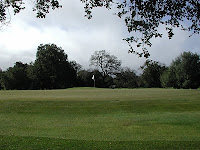 (Click Photos to Enlarge)
(Click Photos to Enlarge)Buildup of Sand between old varsity bunker and green.

Using an excavator to lower the bunker lip at the old varsity area.

Sand buildup on green side of bunker due to heavy use

Beginning to scrape off the sand build-up
At this point in the bunker, about two feet of sand has accumulated on top of the old lip. Shown is the old soil level.
Following the work at the range, the work will proceed to greens #6, #7, and #8 where we have similar problems. #19 green will be the last one to be done.













